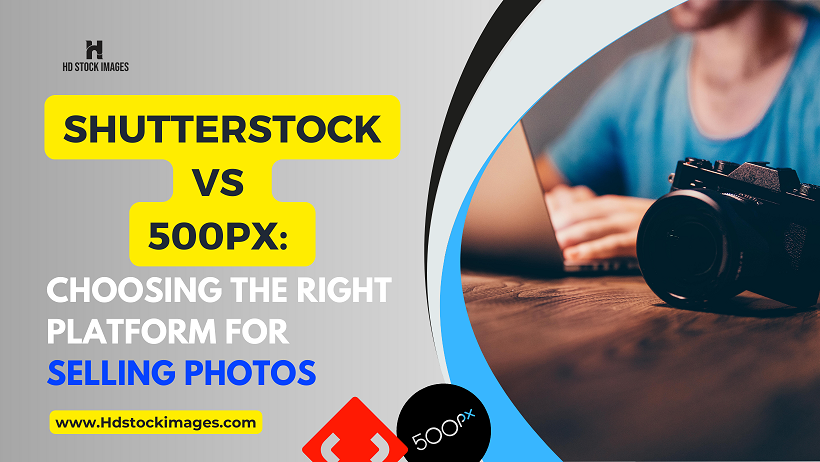1. Introduction
Choosing the right platform for selling photos is crucial for photographers looking to monetize their work effectively. With the rise of digital marketplaces, photographers have numerous options to showcase and sell their images. Two popular platforms that often come up in discussions are Shutterstock and 500px. These platforms offer photographers a way to reach a wider audience, license their images, and generate income from their craft.In this blog post, we will explore the features, benefits, limitations, and considerations of both Shutterstock and 500px to help photographers make an informed decision about which platform aligns best with their goals. Understanding the unique aspects of each platform will enable photographers to maximize their earning potential and leverage the platform that suits their artistic style and target audience.Also Read This: Alamy Payment Method: Options for Receiving Earnings as a Contributor
2. Understanding Shutterstock

A. Background and history of Shutterstock
Shutterstock is one of the largest and most well-known stock photography platforms in the industry. It was founded in 2003 and has since grown into a global marketplace that connects photographers, videographers, and artists with customers seeking high-quality visual content. With a vast library of millions of images, videos, and music tracks, Shutterstock has become a go-to platform for businesses, media organizations, and individuals looking for professional visuals.B. Features and benefits of selling photos on Shutterstock
- Wide customer base and market reach: Shutterstock boasts a massive customer base, including advertising agencies, publishers, designers, and businesses worldwide. This broad market reach increases the exposure and potential sales opportunities for photographers.
- Robust licensing options and pricing models: Shutterstock offers various licensing options, including royalty-free and extended licenses, allowing customers to use images for different purposes. This diversity of licenses provides photographers with the flexibility to monetize their images in different ways, catering to different customer needs.
- Efficient submission and review process: Shutterstock has a streamlined submission process, making it relatively easy for photographers to upload and submit their images. The platform also provides quick review times, ensuring a faster turnaround for contributors.
- Tools and resources for contributors: Shutterstock offers a range of tools and resources to support contributors in optimizing their success. These include keywording and metadata assistance, analytics and performance insights, and educational resources to help photographers enhance their skills and understand market trends.
C. Limitations and considerations of using Shutterstock
- High competition and saturation of content: As one of the most popular platforms, Shutterstock attracts a significant number of contributors. This high level of competition means that photographers need to produce exceptional and unique content to stand out from the crowd.
- Stringent content guidelines and quality requirements: Shutterstock maintains strict content guidelines to ensure the quality and relevance of the images available on its platform. Photographers must adhere to these guidelines, which may involve additional effort and attention to detail during the submission process.
- Lower royalty rates for non-exclusive contributors: While Shutterstock offers competitive royalty rates, non-exclusive contributors may receive lower rates compared to exclusive contributors who provide their content exclusively to Shutterstock. This aspect should be considered when evaluating the potential earnings on the platform.
Also Read This: How Much Do I Make from My Picture Through Getty Images: Understanding Earnings from Photo Licensing
3. Exploring 500px

A. Introduction to 500px and its background
500px is a popular online photography community and marketplace that caters specifically to photography enthusiasts and professionals. Established in 2009, 500px has grown into a platform that showcases and sells high-quality photography from around the world. With its focus on artistic expression and community engagement, 500px offers a unique environment for photographers to showcase their work and connect with a niche audience.B. Unique features and advantages of selling photos on 500px
Focused community of photography enthusiasts: 500px has built a community of passionate photographers who appreciate and value artistic photography. This niche audience provides an opportunity for photographers to connect with like-minded individuals who genuinely appreciate their work.Enhanced exposure and discovery opportunities: 500px emphasizes the discovery of exceptional photography, showcasing top-rated images and featuring photographers through their algorithms and curated galleries. This exposure can lead to increased visibility and potential sales for photographers.Customizable licensing options and pricing control: Unlike some other platforms, 500px allows photographers to have more control over their licensing options and pricing. Photographers can choose from a range of licensing models, including royalty-free and rights-managed, and set their own prices based on their perceived value and market demand.Engaging social interaction and feedback: 500px encourages community engagement and interaction among photographers and enthusiasts. Users can leave comments, provide feedback, and participate in discussions, fostering a sense of community and allowing photographers to gain insights and perspectives on their work.C. Drawbacks and considerations when using 500px
Smaller customer base compared to Shutterstock: While 500px has a dedicated community, it may not have the same vast customer base as Shutterstock. This could potentially limit the number of sales opportunities for photographers, especially if their work caters to a broader audience.Higher competition within the platform: Due to its focus on artistic photography, 500px attracts a significant number of talented photographers. This increased competition within the platform means that photographers need to consistently produce high-quality and distinctive work to stand out and attract potential buyers.Premium membership requirements for certain features: Some advanced features and functionalities on 500px, such as selling prints and accessing detailed analytics, are only available to users with a premium membership. This cost consideration should be factored in when evaluating the overall benefits and potential return on investment.Exploring the unique features, advantages, and considerations of 500px alongside Shutterstock will help photographers determine which platform aligns better with their artistic style, target audience, and objectives. In the following section, we will discuss key factors to consider when making a decision between these platforms.Also Read This: Understanding Adobe Stock Photo Licensing
4. Key Factors to Consider
When deciding between Shutterstock and 500px as the platform for selling photos, it's important to take several key factors into consideration. These factors will help you assess your needs, goals, and preferences, and ultimately make an informed decision.A. Individual goals and objectives as a photographer
Determine your primary goal: Are you looking to generate maximum revenue, gain exposure and recognition, or build a community of like-minded photographers?Assess your long-term aspirations: Consider whether you want to establish a sustainable income stream, explore commercial opportunities, or showcase your artistic vision.B. Target audience and niche market
- Identify your target audience: Understand the demographics, interests, and preferences of the audience you want to reach with your photography.
- Consider the platform's user base: Evaluate whether Shutterstock or 500px aligns better with your target audience and offers better exposure to potential buyers.
C. Licensing and pricing preferences
- Evaluate licensing options: Determine whether you prefer a platform that offers a range of licensing models or one that allows more control over pricing and licensing terms.
- Consider pricing strategies: Assess whether you prefer a platform that sets standardized pricing or one that allows you to set your own prices based on perceived value.
D. Level of competition and content saturation
- Evaluate competition: Research and analyze the level of competition within both platforms to understand how easily your work will stand out.
- Consider content saturation: Determine whether the platform is already saturated with similar images or if there is room for your unique perspective to thrive.
E. Community engagement and social interaction
- Assess the importance of community: Decide whether you prioritize connecting with a community of fellow photographers, receiving feedback, and engaging in discussions.
- Consider the platform's social features: Evaluate the social interaction capabilities of each platform, such as comments, likes, and sharing options.
F. Comparison of royalty rates and earnings potential
- Understand royalty rates: Compare the royalty rates offered by Shutterstock and 500px to assess the potential earnings from each platform.
- Evaluate exclusive and non-exclusive options: Consider whether exclusivity matters to you and how it impacts royalty rates and earnings.
By carefully considering these key factors, you will be able to weigh the advantages and disadvantages of both Shutterstock and 500px based on your unique needs and preferences. In the next section, we will discuss how to make the right choice based on these considerations and personal priorities.Happiness @IndiAves @inbiodiversity @nature_org @WildlifeMag @NatGeoUSA @NikonUSA @TheTiny_Earth @TravelForWildl1 @SanctuaryAsia @USAnwildlifeo @VJSWRITER @Nainamishr94 @WIONews @Shutterstock @500px pic.twitter.com/hSzVCkIzTF
— Odetonature (@odetonature11) August 27, 2022
Also Read This: Discover How to Earn from Shutterstock
5. Making the Right Choice
When it comes to choosing between Shutterstock and 500px as the platform for selling your photos, there are several steps you can take to make an informed decision that aligns with your goals and maximizes your potential for success.A. Assessing personal priorities and requirements
- Review the key factors: Reflect on the factors discussed in Section IV and determine which ones hold the most significance for you.
- Identify your priorities: Consider whether earning potential, exposure, community engagement, licensing control, or other factors are most important to you.
B. Conducting research and gathering feedback
- Explore user experiences: Read reviews, testimonials, and discussions from photographers who have used both platforms to understand their firsthand experiences.
- Seek opinions from the community: Engage with other photographers, join relevant forums or social media groups, and ask for their insights and recommendations.
C. Experimenting and testing the platforms
- Utilize trial periods or free accounts: Take advantage of any trial periods or free account options offered by both platforms to get a firsthand experience of their features and functionalities.
- Upload a sample of your work: Test how your photos perform on each platform by uploading a small selection and monitoring the response and engagement.
D. Considering a combination of platforms or multiple avenues
- Evaluate a multi-platform strategy: Assess the possibility of using both Shutterstock and 500px simultaneously or incorporating other platforms into your selling approach to diversify your reach and increase potential sales.
- Explore other avenues: Look beyond these platforms and consider other marketplaces, your own website, or partnering with galleries or local businesses to expand your selling opportunities.
E. Adapting strategies based on performance and feedback
- Monitor your performance: Keep track of the sales, earnings, and engagement metrics on each platform to evaluate their effectiveness for your photography.
- Gather feedback and adapt: Pay attention to customer feedback, comments, and trends to refine your photography style, marketing strategies, and content selection.
- By following these steps, you can make an educated decision based on your priorities, research, and personal experience. Remember that the choice of platform is not set in stone, and you can always reassess and adjust your strategy based on performance and evolving goals.

 admin
admin








